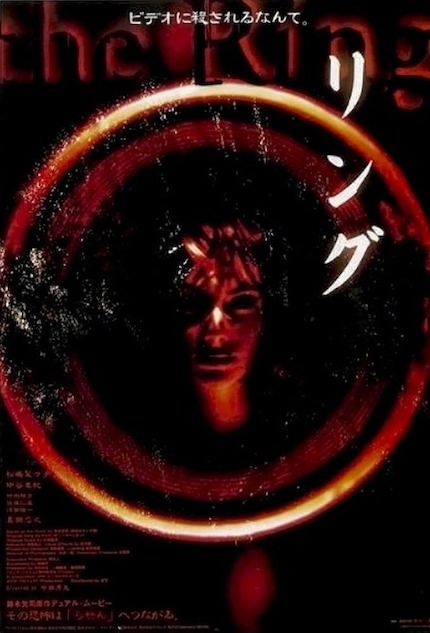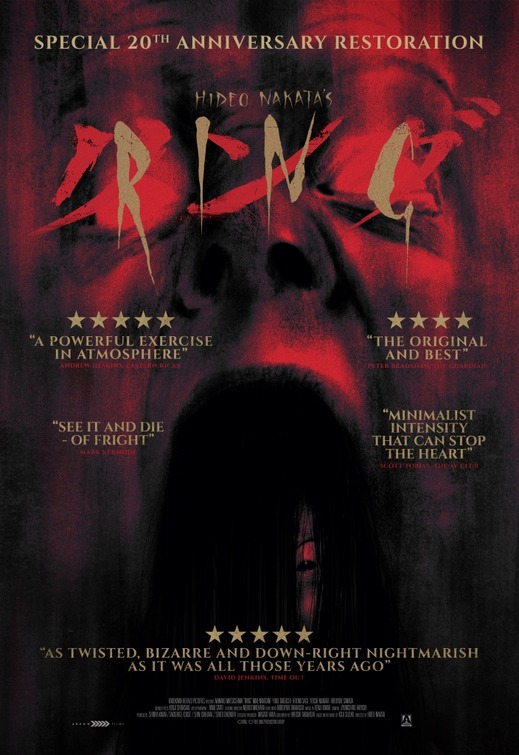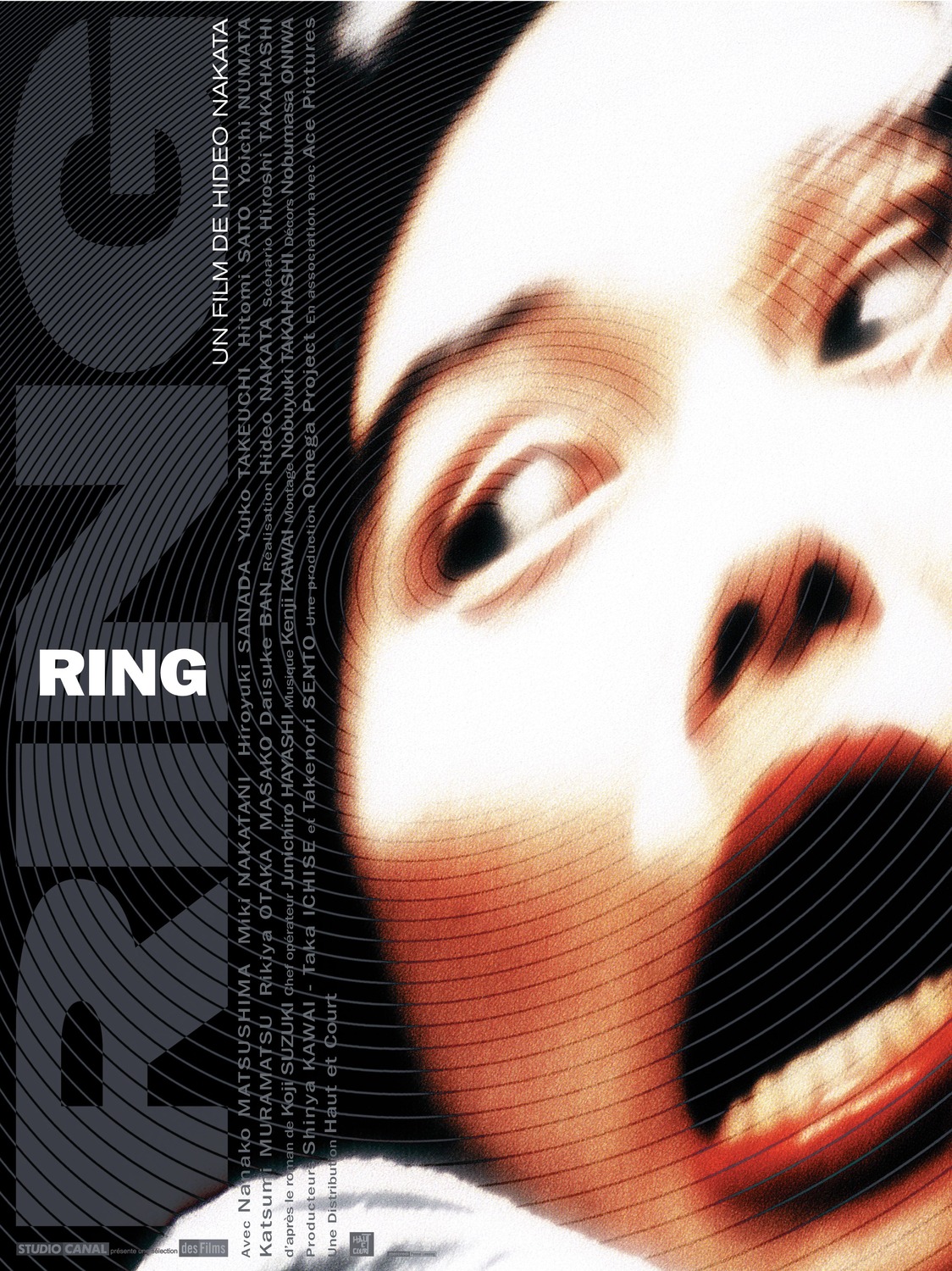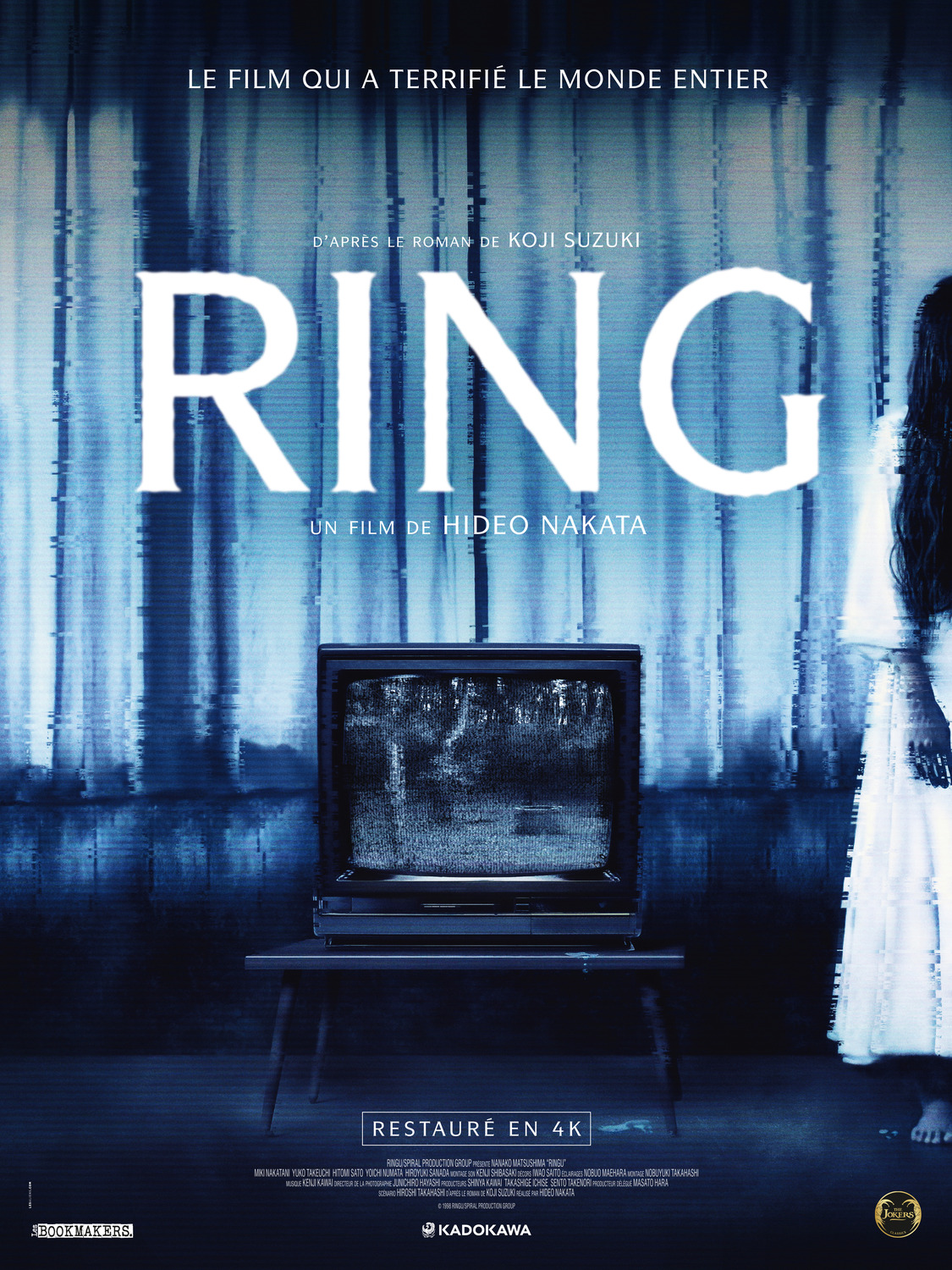Call Me Maybe: Hideo Nakata's RINGU Turns 25

A curse that infects people like a virus; a ghostly girl apparition with long hair — we owe these iconic J-horror images, and many other elements that are now the scary starter kit, to the creators of Ring (orig. Ringu).
This year marks the 25th premiere anniversary of the supernatural thriller by Hideo Nakata, which was first released in Japan in January 2018 and then later screened at the Fantasia International Film Festival in July of the same year, became one of the highest-grossing Japanese horror movies, and basically charted the course for the entire J-horror tradition for many years to come.
In 1991, Japanese writer Koji Suzuki published a novel called Ring, about a malevolent tape that brings a deathly curse on the head of young Sadako Yamamura. The book drew its material from the tragic fates of two historical women, Chizuko Mifune and Sadako Takahashi. Mifune became the inspiration for Sadako's mother. She claimed to have psychic powers, and, upon the insistence of a Tokyo University professor, held a public seance as a spirit medium, which ended with her being declared a fraud.
Shortly afterwards, Chizuko Mifune committed suicide. Sadako Takahashi was born one year before Mifune's death, and also advertised herself as a spirit medium, with the rare gift of nensha: the ability to burn images into objects through sheer willpower.
While not an absolute smash hit, Suzuki's book did enjoy some success, becoming popular enough for the author to later return to the "Ringverse" multiple times in subsequent novels (Spiral, Loop, Birthday, and others) and secure a lucrative movie rights deal. Curiously enough, the novel's first adaptation was actually direct-to-TV. This film, titled Ring: The Complete Edition, was made by Chisui Takigawa in 1995. Almost entirely forgotten today, this version of Ring made every effort to remain faithful to the original novel's plot: it had the same protagonist as the book, Kazuyuki Asakawa, a male journalist investigating the bizarre deaths, whom the next film adaptation would "gender-swap".
At the time when Hideo Nakata began working on his own version of Ring, his reputation as a horror maker was mostly founded on Don't Look Up (Ghost Actress in original Japanese), a film that he'd made in 1996. In a way, Don't Look Up came into being by accident, born out of Hideo Nakata's great love towards the English director Joseph Losey.
Back in the day, Nakata was making his first professional steps at Nikkatsu, a Japanese studio specializing in films known as "roman porno", a variation of "pinku eiga", or "pink films": exploitative flicks filled with erotica and violence. In 1991, Nakata decided to set his practical work aside for a short while and travel to London, to study the British Free Cinema.
And in 1993, he suddenly discovered that he would be unable to return to his former employers: the home video boom had driven Nikkatsu into bankruptcy. Nakata, in the meanwhile, was determined to make a documentary about Losey; in order to save up enough money for the budget he needed, he started taking commissions for various feature projects.
One such project was Don't Look Up: the story of a director who’s trying to make a film debut but finds that his footage has been inexplicably interspersed with odd frames of a ghostly girl with long black hair. The feature had a tight budget — pushing Nakata to get creative and experiment with a minimalist style — and was mostly shot in the abandoned Nikkatsu studio building. Don't Look Up wasn't particularly successful and did not have a long theatrical run in Japan, but it did take part in several film festivals, where Nakata caught the eye of the right people.
It was thanks to this festival spotlight that Nakata was approved for directing a new film adaptation of Suzuki's novel. And in case you were wondering, he did end up finishing his film about Losey: the documentary, titled The Man with Four Names, was released in the same year as Ring.
To create Ring's screenplay, Nakata called on the writer Hiroshi Takahashi, who had worked with him on Don't Look Up. In Nakata and Takahashi's version, the journalist protagonist was changed from male to female, renamed Reiko Asakawa, and made a divorcee (unlike Suzuki's protagonist, who was married), as Nakata found it essential to demonstrate that the traditional family model was no longer viable.
Nakata took the main “meat” of the plot, which Koji Suzuki himself had described as a mix of the Poltergeist film and traditional Japanese folklore, and added his own imagery, creating a film canon that would rewrite the history of J-horror for the entire next decade. The parallels between Ring and Japanese folk legends become especially obvious in the character of Sadako. She is strongly reminiscent of yūrei, Japanese ghosts that are commonly portrayed as young women in long white garments, with unbraided hair and (quite often) no feet.
Plot-wise, Sadako's story has the most similarities with a Japanese legend titled Bancho Sarayashiki: the tragic tale of a serving maid by the name of Okiku. It is said that Okiku rejected the salacious advances of a samurai, who then murdered her and tossed her into a well. In Suzuki's original novel, Sadako was, likewise, an assault victim, raped and murdered by a doctor, who also disposed of her body in a well. The well from Okiku's story is, in fact, quite real, and still remains one of the main landmarks at the legendary Himeji Castle in western Japan.
Wells as an image — featured pretty heavily in Nakata's film — are a fairly important part of Japanese folklore, as the final resting place of multiple heroines of yūrei stories. One of the most renowned instances of a well being symbolically used in cinema is Kaneto Shindo's classical horror Onibaba (1964), where the female protagonists lure soldiers into a deep hole concealed among reeds.
The motif of water is symbolic as well. In many Japanese legends, water is a conduit between the world of mortals and the spirit realm. Nakata will keep building on this symbolic element in his adaptation of Koji Suzuki's other novel, Dark Water (2002), and in The Ring Two (2005), sequel to Ring's American remake.
Another classical yūrei character that helped shape Sadako is the ghost of Oiwa from Yotsuya Kaidan. In this legend, Oiwa's husband falls in love with another woman, brutally murders his wife, and throws her body in a river. This textbook yūrei ghost story has often been used as a reference point by J-horror creators. For example, Kayako, a character from another Japanese horror franchise, Ju-On (The Grudge), has the same backstory.
But the overlap between Sadako and Oiwa does not end at their similar circumstances: the kabuki theater production of Yotsuya Kaidan contains an iconic scene where Oiwa's ghost brushes her long black hair, which completely obscures her face. At some point, the ghost lifts her head, revealing the mutilated features of the murdered young woman. A woman carefully brushing her hair is one of the most famous, and the most frightening, images from Sadako's cursed tape in Nakata's film.
Sadako's now-canonical portrayal, with her face hidden from the audience for most of the film, is not just a nod to tradition, but also a conscious creative decision on Nakata's part. The director has admitted multiple times that his previous work's main weakness was that he showed the titular ghost actress' face far too often and in too much detail, leaving little room for imagination. While working on Ring, Nakata decided to utilize a fundamentally new horror methodology, when the goal is not to startle the viewer with shocking jumpscares, but to prompt them to fill in the gaps within their mind, completing the horrifying images on their own.
There is one point, however, where Ring diverges radically from national folklore: the concept of how Sadako enacts her revenge. In Japanese mythology, vengeful spirits of the dead (usually women that suffered in life at the hands of treacherous men) are called onryō, and considered the cruelest out of all yūrei.
The motifs of restoring karmic justice and helping a restless soul find peace are integral to kaidans (ghost stories) about yūrei, but when Suzuki was writing his Ring, he came up with an utterly unprecedented concept, which Nakata brought to life through the very structure of his film. Sadako's curse functions as a virus, and its only driving force is to infect people as efficiently as possible. This concept, which goes against the classical ideas of restoring justice and returning to the status quo, will also be examined by other directors after Nakata: Takashi Shimizu in many versions of Ju-On and Takashi Miike in One Missed Call (2003).
Much as Nakata makes nods to Japanese myths and legends, a sizeable part of Ring is dedicated to the struggle of the new against the traditional. Scholars studying both this film and Nakata's subsequent body of work have noted multiple times that the director uses the characters of Reiko and Sadako to raise the issue of women's status in modern Japan, as opposed to the balance of power in the past.
The Old versus New conflict also manifests in the transmission method of Ring's viral curse: through technological advancements like the video recorder, the TV, and the phone. The overall concept of spirits haunting material objects is not that unorthodox: in Japanese culture, ghosts and other paranormal entities naturally coexist with the human world, and it is commonly believed that everyday items possess a soul. What makes Ring innovative is that the supernatural specifically inhabits tech.
In a few years' time, the destructive nature of the very technology that was meant to make people's lives easier will be expanded on by Gore Verbinski in his brilliant The Ring (the US remake of Nakata's film), and by Kiyoshi Kurosawa in Pulse (2001), another J-horror staple. Nakata does not explicitly demonize technology; but he does show a world where people have already gotten used to relying on shiny new gadgets that do not bring them closer together, but instead leave them even more vulnerable, one on one with the inescapable doom.
The sensation that there is no way to prevent what is about to happen permeates the very fabric of Nakata's film. The central image of a ring (as Koji Suzuki himself explained, the novel's title is a reference not as much to a phone ringing, as to a circular shape) dominates over the film's narrative structure, where the images from the cursed videotape repeatedly appear on-screen, turning in on themselves in the finale in a deadly loop.
It's worth noting that Ring starts with a scene that seems to belong to a completely foreign cultural tradition: two teenage girls, home alone, passing the time by telling ghost stories about a tape that kills people. This prologue, seemingly borrowed from American teen horror, sets the tone for the entire story that follows.
During the opening episode of the film, the viewer, along with the characters, balances between paranoid fear and illusory safety. This contrast underlies the entire film, with its deceptively slow-burn pace. In a sense, the film's deliberate minimalism creates an immersion effect that will subsequently be most enthusiastically exploited in the found footage genre.
Ring's main special effects are revealed in the final climax scene, when Sadako appears. To give the ghostly girl her uncanny gait as she climbs out of the TV, kabuki theater actress Rie Inō, who plays Sadako, was filmed walking backwards; then, the footage was reversed. Sadako's distinctive movements, which have terrified more than one generation of viewers, were inspired by the traditions of a unique Japanese dance, butoh, or "dance of darkness", characterized by sharp, grotesque motions.
This scene, perhaps the most memorable and notorious part of Nakata's film, is styled in a very subdued manner. By using minimal editing, the director makes the viewers feel like they are right there, completely immersed in the situation, and utterly helpless in the face of the inevitable.
To understand just how much the cinematic language proposed by Nakata differs from the era's mainstream horror, one might compare the film's climax with its later revision in the (otherwise outstanding) American remake. The energetic cross-cutting used by Verbinski might make the scene more dynamic, but this comes at a cost: the holistic immersion is disrupted and the audience is torn out of the nightmare's vice-like grip.
Nakata's Ring was shown in theaters in 1998, becoming a domestic box office hit and later a worldwide sensation. Its international release coincided with that of another horror phenomenon: The Blair Witch Project, by Eduardo Sánchez and Daniel Myrick. One should bear in mind that during that period, the horror genre was somewhat stagnating.
The 1990s certainly were an odd decade for scary flicks. The new generation of slashers, which kept on multiplying after the success of Wes Craven's self-aware Scream (1996), was deliberately packed with tropes, overflowing with genre rules and archetypes. The creations of Nakata and the Sánchez-Myrick duo, for all their stylistic differences, both stood apart from the slasher crowd, as heralds of an unprecedented new kind of horror.
The Blair Witch Project was a full-fledged horror mockumentary, and Ring, too, touched upon the documentary form, in its own way. Guided by Junichiro Hayashi (whose signature shooting style will return several years later in Kiyoshi Kurosawa's Pulse and Nakata's Dark Water), the camera glides along the precariously rippling surface of everyday reality, studying it thoughtfully, drowning the audience in an all-encompassing disturbing atmosphere. As it turned out, this meditative submersion into nightmare made far more of an impact than the Craven-esque jolly scares.
Gore Verbinski's version of it, The Ring, further fanned the flames of public interest towards Asian horror. The Ring is a rather curious and not too common example of a foreign remake that, on the one hand, respectfully pays homage to the main themes and atmosphere of the original, and on the other, expands the narrative with new meanings, successfully transplanting Japanese images into the soil of American culture.
For instance, where the visuals from Nakata's film were closely linked to reinterpreting classic Japanese legends and kabuki theater characters, Verbinski turned his attention to the paintings of the famous American artist Andrew Wyeth, notable for their poetic depiction of loneliness, hopelessness, and a sense of impending disaster, all wrapped up in an indifferent landscape.
Following the success of The Ring, both the critics and the public, in their search for more works with the same oppressive sense of anxiety, were once again drawn to Asian horror, which at the time was hitting its peak. This spike of interest launched a real conveyor belt that kept spitting out American remakes of each and every Asian horror feature that was at least marginally impactful. Thus, the Japanese Pulse, Ju-On, One Missed Call, and Dark Water, the Korean A Tale of Two Sisters (originally Rose Flower, Red Lotus, 2003), the Hong Kongese The Eye (2002), the Thai Shutter (2004), and countless other films gained their own English-language versions.
And the image of Sadako, the famous Japanese dead girl in white, spawned copies upon copies across numerous remakes, sequels, parodies and crossovers, such as Sadako vs. Kayako (2016). With time, Sadako turned into a standalone pop culture phenomenon: you may recall, for example, her memorable guest appearance during a baseball match in Tokyo in April 2012 .
The reboot of horror in both Ring and The Blair Witch Project sent the genre in an all-new stylistic direction, breathing a kind of refreshing sincerity into it, though obviously, as years went by, the unfiltered mockumentary techniques outstayed their welcome. The shaky cam effect, which used to be so new and exciting when Sánchez and Myrick used it, made the latest iteration of Blair Witch (released in 2016) entirely unwatchable.
That said, Nakata's keen, contemplative gaze is still as relevant as it was in 1998. After all, it was Ring that prompted horror fans from around the world to pay attention to not just Asia, but other countries as well, to discover the new breed of revisionist French, British, Spanish, Latin American, Scandinavian and other horror films that has long been lying in wait, ready to lunge at the unsuspecting viewer like Sadako crawling out of a TV.
The film is now streaming on a variety of platforms: AMC+, Arrow, AsianCrush, Screambox, and Shudder, among others; it is also available to buy or rent. Visit JustWatch for links to each platform.













